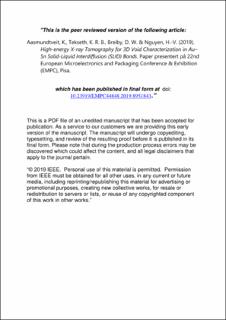| dc.contributor.author | Aasmundtveit, Knut | |
| dc.contributor.author | Tekseth, Kim Robert Bjørk | |
| dc.contributor.author | Breiby, Dag Werner | |
| dc.contributor.author | Nguyen, Hoang-Vu | |
| dc.date.accessioned | 2020-04-22T07:14:52Z | |
| dc.date.available | 2020-04-22T07:14:52Z | |
| dc.date.created | 2020-03-11T11:46:55Z | |
| dc.date.issued | 2019 | |
| dc.identifier.isbn | 978-0-9568086-6-0 | |
| dc.identifier.uri | https://hdl.handle.net/11250/2651969 | |
| dc.description | This is a PDF file of an unedited manuscript that has been accepted for publication. As a service to our customers we are providing this early version of the manuscript. The manuscript will undergo copyediting, typesetting, and review of the resulting proof before it is published in its final form. Please note that during the production process errors may be discovered which could affect the content, and all legal disclaimers that apply to the journal pertain. | en_US |
| dc.description.abstract | Au-Sn SLID bonding is a technique originally developed for harsh environment applications. The technology has recently shown promising results for ultrasound transducer fabrication. Characterizing the spatial and size distributions of voids is crucial for developing a fabrication process that satisfies acoustic requirements. This measurement is traditionally done by optical or electron cross-section microscopy that gives the void distribution in a randomly selected physically cut plane. X-ray micro computed tomography is a powerful tool for non-destructive three-dimensional imaging of void distributions, but is challenging to use in high-density materials like the ones used in ultrasound transducers. We demonstrate that monochromatic, high-energy synchrotron X-ray tomography can give 3D images of such a challenging sample, resolving μm-sized voids in the bondline. The void distribution is highly non-uniform, implying that traditional cross-section microscopy would give different results depending on the plane of sectioning. Computed tomography allows the voids to be parametrized and treated statistically, revealing a wide distribution of void sizes, a tendency to form oblate voids with size-dependent orientation, as well as porous networks. | en_US |
| dc.language.iso | eng | en_US |
| dc.relation.ispartof | 2019 22nd European Microelectronics and Packaging Conference & Exhibition (EMPC) | |
| dc.title | High-energy X-ray Tomography for 3D Void Characterization in Au–Sn Solid-Liquid Interdiffusion (SLID) Bonds | en_US |
| dc.type | Chapter | en_US |
| dc.description.version | acceptedVersion | en_US |
| dc.rights.holder | “© 2019 IEEE. Personal use of this material is permitted. Permission from IEEE must be obtained for all other uses, in any current or future media, including reprinting/republishing this material for advertising or promotional purposes, creating new collective works, for resale or redistribution to servers or lists, or reuse of any copyrighted component of this work in other works.” | en_US |
| dc.identifier.cristin | 1801124 | |
| dc.relation.project | Norges forskningsråd: 235302 | en_US |
| dc.relation.project | Norges forskningsråd: 262644 | en_US |
| dc.relation.project | Norges forskningsråd: 245963 | en_US |
| dc.relation.project | Norges forskningsråd: 275182 | en_US |
| cristin.ispublished | true | |
| cristin.fulltext | preprint | |
| cristin.qualitycode | 1 | |
